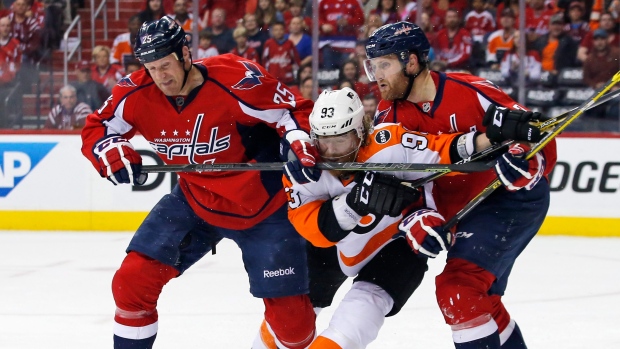Apr 18, 2016
How the Capitals cooled off the Flyers
Through the first two games, Washington has done a masterful job of matching their best defensive pairing against Philadelphia’s top line, Travis Yost writes.
By Travis Yost

I’ve talked a lot in the past about how the combination of the NHL’s messy regular season point allocation and bizarre divisional playoff format lends itself to unbalanced round-one matchups. As a person who wants to see best versus best above all else, I get a bit frustrated when two great teams — or two subpar teams — draw in against one another in the quarterfinals.
While I continue to argue that some of this is self-inflicted (there’s really no good reason for the current divisional playoff format, which only serves to add another layer to the seeding process), some of it is also unavoidable. Case in point: How do you control for the team that looks night-and-day better during the second-half of the season, racking up points at a frenetic pace en route to one of the final playoff berths?
That part is probably the beauty, and cruelty, of sport. The Flyers are this year’s example – a team that demonstrably improved down the stretch and, despite their current deficit against the Capitals, a team I’d still argue is a fair bit better than their full season record shows.
I’m pretty sure the Capitals recognize it too. For a team that was 16 points clear of their nearest Eastern Conference competitor, I can’t imagine that Barry Trotz was over the moon with their round-one draw.
I do think the sign of a great team is one that can overcome this sort of adversity, and it’s impossible not to notice the bang-up job the Capitals did against the Flyers in the first two games of the series. A lot will be made about Steve Mason’s absurd centre-ice goal against, but I think far more noticeable is the fact that the Flyers have all of one goal on Braden Holtby in two games. This is a Flyers team, remember, that scored at an identical pace as the high-flying Stars during the second-half of the season.
So, how are the Capitals doing it? At least with home ice, a lot of it was a fully dedicated team effort to hard match against the Philadelphia top line, letting the chips fall as they may when it came to depth on depth. This meant addressing the Philadelphia trio of Claude Giroux, Wayne Simmonds and Jakub Voracek – the team’s three most electric scorers, and three guys who have all of one point through the first two games.
To slow that group down, Washington’s simply hard-matched their most competent defensive pairing against Giroux, et al., with some help from their most deadly offensive trio.
Here are the shift charts from the first two games (the coloured bars indicating when a player was on the ice at a given time). In Game 1, you’ll notice that the Matt Niskanen/Karl Alzner pairing stuck to the Giroux line like a bad habit.

That’s pretty dedicated effort. But they elevated their effort in Game 2, with some help over the top in the form of Alexander Ovechkin, Nicklas Backstrom, and T.J. Oshie.

The amazing thing here is the only time Philadelphia’s top group’s really found daylight through the first pair of games – the Voracek goal midway here – was in an exceptionally rare moment when the five-man Washington unit had broken up.
Altogether, the Giroux line has seen the Niskanen/Alzner pairing in 84 per cent of the minutes they’ve played in the series. That’s a number I have trouble wrapping my head around, especially since many NHL shifts start on the fly, where it’s a bit more difficult to hard match. It’s even more impressive when you remember that a good portion of that 84 per cent also included the Capitals’ vaunted collection of goal scorers.
It’s going to be fascinating to see what Philadelphia does with home ice for Game 3. My guess is they’re going to try and get the Giroux line out as much as possible, but probably against a more diversified set of competition (and likely with more minutes against a less mobile John Carlson/Brooks Orpik pairing).
Either way, Philadelphia needs to do something. They’re not down and out on the mat just yet, but they’re teetering. Game 3 will be huge.


